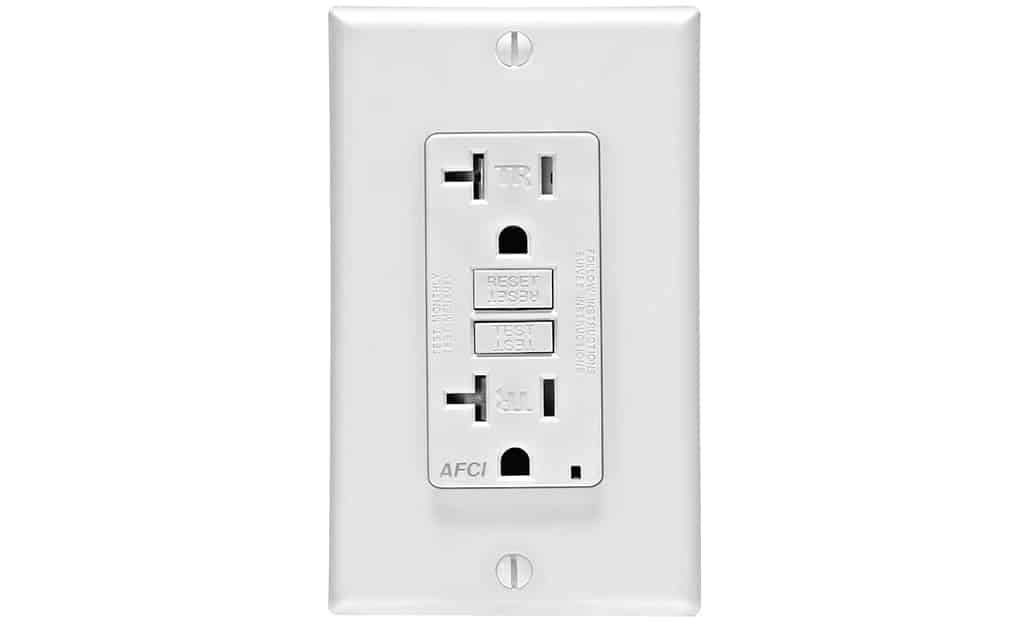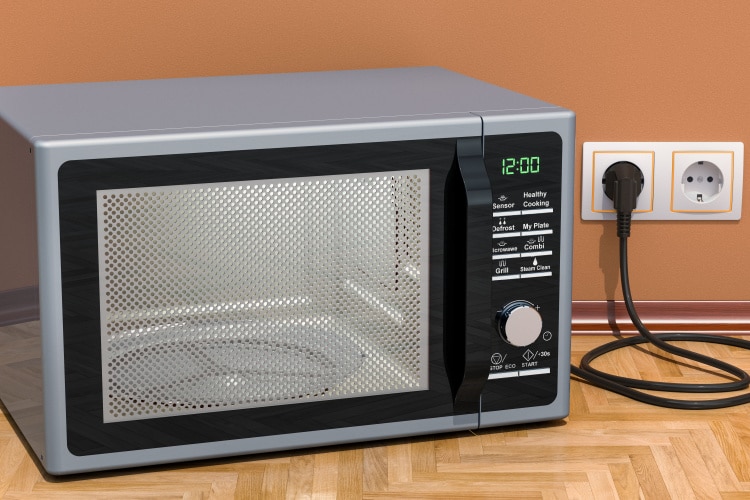Using a microwave and a hair dryer simultaneously consumes a lot of electricity, but will it be too much for a standard wall outlet?
Typical outlets can withstand a sizable amount of power before they become a fire hazard. Most US wall outlets support up to 2400 watts per plug. But what does this number tell us about how many devices you can plug at once, and also, which ones?
In this post, we’ll examine the peak energy of wall outlets and what determines it. There are a lot of calculations and technical terms involved, but don’t worry! We’ve made this overview simple and straightforward so that you can follow along. Let’s get started.
How Many Watts Can a Standard Wall Outlet Handle?
Most home circuits carry 15 or 20 amps, so the maximum capacity before the breaker trips is either 1800 watts or 2400 watts per outlet.

Nevertheless, as a general guideline, limiting your load to 1,500 watts per outlet or circuit is the safest option because a lot of wall outlets may have lower limits. To optimize electricity usage per outlet, we’ll explain how to calculate an outlet’s maximum wattage further in the article.
The number of electronics you can power into a single outlet depends on how many watts each device consumes. For example, big kitchen appliances like the fridge or the dishwasher use more than 1,000 watts on their own. This means you should avoid connecting anything else to the same outlet if a fridge or a dishwasher is already plugged in.
You can see how much wattage devices have by checking their user manual.
Understanding Measurements of Electricity: Amps, Volts, and Watts
To better understand how many watts an outlet can handle, we need to learn more about the measurements of electricity: amps, volts, and watts.
Overall, wires, the metal objects that convey electrical force over a distance, are the means through which electricity moves. If we want anything to be electrically connected from one place to another, we use wires to carry the electrical force.
A wire is covered in a rubbery insulator to transmit electrical power only within the cable. This way, the electrical energy is transmitted to great distances without escaping. The process is remarkably similar to water flowing through a pipe.
We use volts, amps, and watts to describe how much electrical force is transmitted to anything requiring energy. But what do these measurements mean?
Voltage is the pressure or speed of electricity within the wires. The amperage is how much electricity passes through the wire (volume). Amps multiplied by volts equals watts. The formula tells us that the power of electricity is calculated by multiplying its volume and speed – how much of it is flowing through the wire and how fast’.
A conventional wall outlet can only withstand limited wattage when powering an electrical device. If the wattage is too high, the circuit shuts off the electricity as a safety measure.
However, it’s helpful to know what wattage is too high before you even plug the devices. Relying on those safety mechanisms shouldn’t be your only protection. So, let’s learn how to calculate the watts of a standard wall outlet.
Calculating the Watts of a Standard Wall Outlet
Following the formula from above, the amperage of a circuit breaker multiplied by the volts of a wall outlet will tell us how many watts that outlet can handle.
The US’s three typical home circuit breaker sizes are 15 amps, 20 amps, and 30 amps. As for wall outlets, most houses usually have 110 or 120 volts of electricity per outlet.
Before we jump to the calculation, we need to explain the National Electrical Code 80% rule, sometimes known as NEC 80%. It’s a fundamental safety precaution implemented to keep your outlet from catching fire, and here’s what it means.
According to the National Electrical Code, an outlet can only carry 80% of the electrical power from the home circuit breaker. So, connecting a wall outlet to a 15 amps circuit breaker draws 12 amps of electricity at most (because 80% of 15 amps is 12 amps).
Considering this vital precaution, let’s illustrate the calculation with an example. We’ll continue with the 15 amps circuit breaker example. As for the wall outlet, let’s say it’s 110 volts.
Your first step should always be to apply the NEC 80% rule to the amps of the circuit breaker. Then, you need to multiply the circuit breaker’s amps by the outlet’s volts. The result is how many watts that outlet supports. In our example, that equals 1,320 watts.
110V wall outlet with a 15A circuit breaker: 110 Volts x 12 Amps (80% rule) = 1,320 Watts
A Chart With Precisely Calculated Outlet Wattage
| Voltage | Amperage | Wattage |
|---|---|---|
| 110V | 15A | 1320W |
| 110V | 20A | 1760W |
| 110V | 30A | 2640W |
| 115V | 15A | 1380W |
| 115V | 20A | 1840W |
| 115V | 30A | 2760W |
| 120V | 15A | 1440W |
| 120V | 20A | 1920W |
| 120V | 30A | 2800W |
| 220V | 15A | 2640W |
| 220V | 20A | 3520W |
| 220V | 30A | 5280W |
| 230V | 15A | 2760W |
| 230V | 20A | 3680W |
| 230V | 30A | 5520W |
| 240V | 15A | 2880W |
| 240V | 20A | 3840W |
| 240V | 30A | 5760W |
Don’t Go Over the Watts Limit
The National Agricultural Safety Database states that overloading a circuit is a major factor in home fires. In fact, electricity failures cause a staggering number of 51,000 residential fires each year.
When it happens, the electrical overload overheats the wiring insulation, damages the wire, and eventually causes a fire.
Your home’s electrical system should be inspected and updated to prevent a fire threat. In particular, you need to consider taking action if:
- Circuit breaker repeatedly trips
- You have older, substandard wiring
- There’s a burnt scent that lingers and has no obvious cause
- You have burned outlets
Appliances That Require Their Own Circuit & Wall Outlet
We all have a ton of electrical gadgets in our homes, including microwaves, refrigerators, air conditioners, and refrigerators.
Due to their reputation as power hogs, each appliance in the following list needs a separate circuit and outlet. Otherwise, you will quickly overload the circuit and run the risk of fire.

List of electronics that require their own outlet.
- Ranges
- Refrigerator
- Garbage disposal
- Wall Ovens
- Microwave
- Dishwasher
- Freezer
- Washer & Dryer
- Heat pump
- Furnace
- Air conditioner
- Electric baseboard heating
- Ceiling fans
- Slow cookers
- Food processors
- Sewing machine
What Wattage Can An Outdoor Outlet Support?
An outdoor outlet supports a maximum wattage of 1250W. The wire for outdoor outlets is thinner and less insulated than for inside outlets. As a result, outside outlets can only handle so much power before they get too hot.
Conclusion
Overall, most contemporary household circuits are 15 or 20 amps. They typically operate on an outlet with 120 volts of power, so the best practice is to keep your load to 1500 watts per outlet or circuit.
It’s not recommended to go over the watts limit because you will overload the circuit breaker and, in a worst-case scenario, start a fire.
Frequent tripping of the circuit breaker, a burned odor, or browned outlets are the main warning indicators of an electrical overload.
Also, keep your wattage to a minimum if your wiring is outdated because old electrical systems weren’t built to support as many modern gadgets in a home as we use today.
Thank you for this helpful article. I am in a home built in 1970 in Asheville area, North Carolina. I have a standing one 60 watt bulb lamp and 2.8 cu ft fridge, no freezer included on a power surge outlet. I want to have a food warmer or one burner hotplate. The hot plate is 1000 watts, would be used briefly. The food warmer operates on a car charger 12V, 24V, or can plug into a wall socket.
Can I use this on the same power outlet?
Thank you if you can help me. I am elderly, completely disabled and trying to make things easier.
Hi Chana, thank you for your question. The most accurate way for me to answer your question would be if I knew the make and model of both the fridge and the hot plate and also to know how many amps your outlet is rated for / what amp circuit is providing power to that outlet. Without that important information, I can only give you a general answers.
If you have a weaker normal outlet that you find bedrooms, it can be rated as low as 1,200 Watts. More typically, you would hope to find that most circuits around the house providing power to your outlets are a 15 amp rated one. A 15 amp circuit provides about 1,800 watts to your outlets. So, that’s one part of the equation to talk about power in terms of Watts. However, there’s a second part of the equation we also need to respect and that is the overall draw of your fridge and hot plate. The amps is the draw of the electricity.
A small 1,000 Watt hot plate will draw around 5-8 amps of electricity. A small mini fridge will draw around 2-3 amps. Back to power and Watts, you mentioned the hot plate is rated at 1,000 Watts. The mini fridge probably uses around 100 Watts normally and maybe 200-300 Watts when first starting.
As you can see, it appears that you should be OK if you are on a 15 amp circuit. But, if you are on a weaker 10 amp circuit, things are getting very close to being an issue. I hope this information helps. If you share the exact makes and models of your appliances, I can research to give you a more refined answer of how much draw (amps) and power (Watts) you will need from your circuit.
i really enjoyed reading your very helpful response. thank you for sharing.
i am a beginner in studying electricity. My basic question is: where do I check to find out the amps for each circuit?
Thank you for your help. Sincerely, Mary
Thanks for reading and your feedback, Mary. The easiest way generally is to check your fuse box, if it is well documented and labeled there. That’s the best way to get the right information without any special knowledge or tools.
Dear Mister Elder,
Thanks much for your helpful subject article and website Q&A’s.
I noticed at the bottom of your article sub-titled “Calculating the Watts of a Standard Wall Outlet”, the example of “110V wall outlet with a 15A circuit breaker: 100 Volts x 12 Amps (80% rule) = 1,320 Watts ” is of course in error. I believe you meant for the Volts to be 110, rather than 100.
Happy Holidays!
Todd
Hi Todd, thank you for reading and appreciate the heads up on the typo you spotted. We’ve now adjusted that formula to read correctly. Happy Holidays!